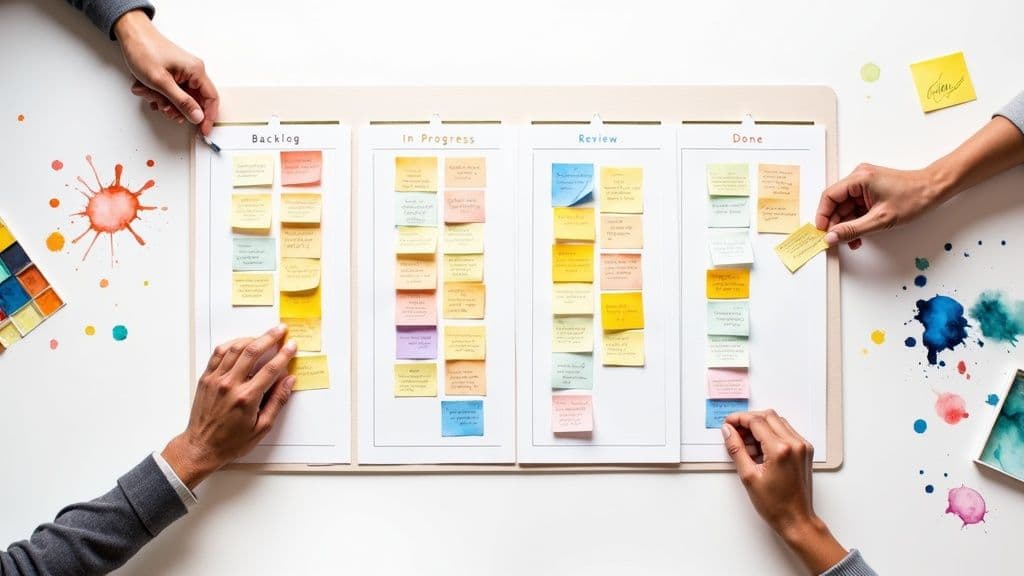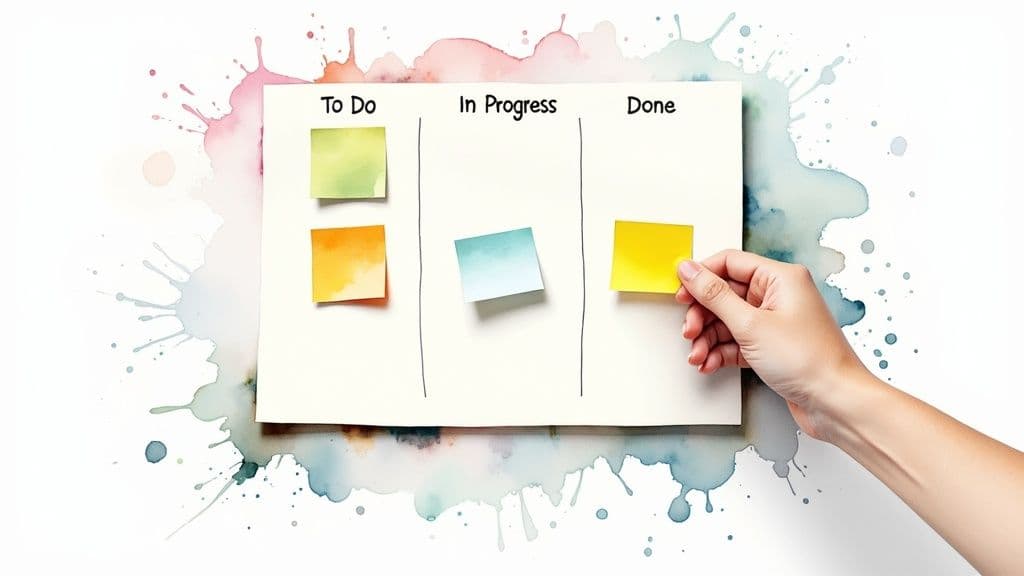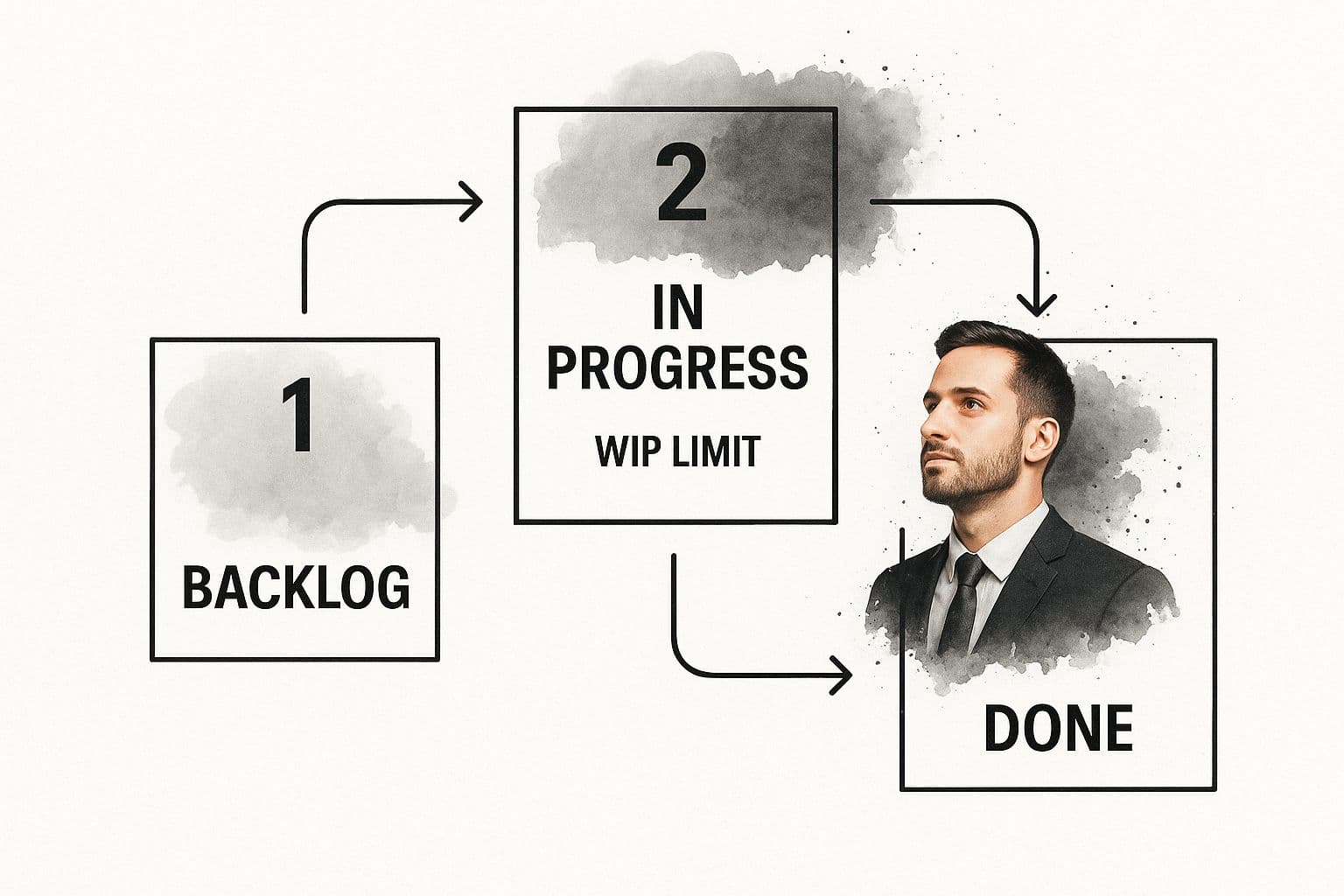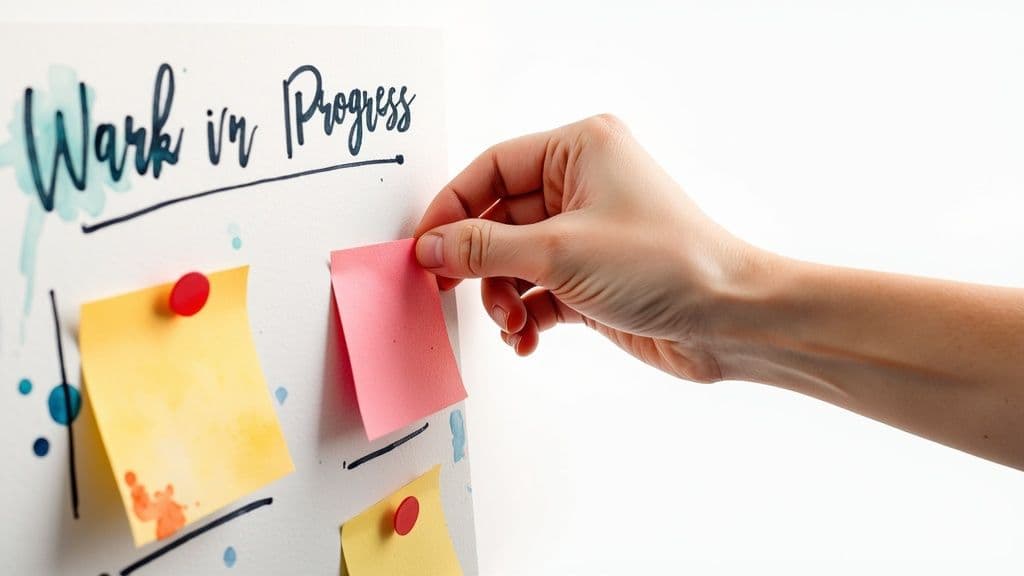Master Kanban board project management with actionable strategies. Move beyond the basics to optimize your workflow, manage tasks, and drive real results.
July 4, 2025 (5mo ago)
Kanban Board Project Management Done Right
Master Kanban board project management with actionable strategies. Move beyond the basics to optimize your workflow, manage tasks, and drive real results.
← Back to blog
Kanban board project management is a fantastic visual system for managing work. It's not just about seeing your tasks; it's about limiting how much you're working on at once and maximizing your team's efficiency. Think of it as evolving beyond a simple to-do list into a living framework that brings clarity, highlights bottlenecks, and ultimately helps your team deliver work on a predictable schedule.
Why Kanban Is More Than Just Sticky Notes

When you hear "Kanban," the first image that probably pops into your head is a whiteboard plastered with colorful sticky notes. That’s a fair start, but it really only scratches the surface of what this project management philosophy is all about. At its heart, Kanban is a method for creating a smooth, predictable flow of work from the moment a task begins until it's completely finished.
One of the best things about Kanban is its flexibility, especially when compared to other, more rigid methodologies. It’s built around the idea of continuous improvement. You don't have to throw out your current processes and start from scratch. Instead, Kanban meets you where you are and helps you evolve.
Visualizing Your Actual Workflow
The real magic of a Kanban board is how it makes invisible work visible. Every single task, from a rough idea to the final deliverable, is represented by a card. These cards then travel across columns that mirror the actual stages of your workflow—not just some generic "To Do," "Doing," and "Done."
For instance, a content marketing team’s board might look much more specific:
- Idea Backlog:** A holding pen for all potential content topics.
- Research & Outline: The first real step where an idea gets some structure.
- Drafting: The writing is officially in progress.
- Editorial Review: The draft is being checked for quality, tone, and accuracy.
- Ready for Publish: The content is finalized and just waiting to go live.
- Published: The work is complete and out in the world.
This level of detail means anyone on the team can see the exact status of every project at a glance. It cuts through the fog and pretty much eliminates the need for those constant "just checking in" status meetings.
Embracing Limits to Boost Productivity
Now, here’s the part that often feels a bit counterintuitive but is incredibly powerful: limiting your Work in Progress (WIP). It sounds strange, right? Do less to get more done? But it's true. By setting a hard limit on how many tasks can be in any single column at one time, you stop team members from juggling too much.
This focus on finishing tasks before starting new ones is the key to reducing chaos. It prevents work from piling up in a "nearly done" state and forces the team to swarm on blockers to keep everything moving.
The core principles of Kanban are what make it so effective. They're not just abstract ideas but practical guidelines for improving how your team works together.
Kanban Principles in Action
| Principle | Practical Application in Project Management |
|---|---|
| Start with What You Do Now | Don't disrupt your current process. Apply Kanban directly to your existing workflow and look for opportunities to improve over time. |
| Agree to Pursue Incremental, Evolutionary Change | Focus on making small, continuous improvements rather than large, radical changes that can be met with resistance. |
| Respect the Current Process, Roles & Responsibilities | Kanban doesn't require immediate organizational changes. It acknowledges that your current setup has value and seeks to improve it. |
| Visualize the Workflow | Use a Kanban board to see every step of your process. This transparency helps identify bottlenecks and areas for improvement. |
| Limit Work in Progress (WIP) | Set limits on the number of tasks in each stage of the workflow. This prevents overburdening the team and improves flow. |
| Manage Flow | Monitor, measure, and report on the movement of work through your system. The goal is to make the flow smooth and predictable. |
By adopting these principles, teams can shift their focus from just being busy to effectively delivering value.
This shift has been a huge reason for its widespread adoption. The first State of Kanban Report revealed that 76% of users found Kanban more effective than other methods they'd tried. It has grown well beyond its origins in software development and is now common in consulting, financial services, and engineering. You can dive into more data on its industry impact in the full 2021 report from Kanban University.
Ultimately, Kanban board project management helps teams deliver value to customers faster by focusing on flow efficiency, not just keeping everyone busy. It’s a system built for clarity, focus, and delivering results you can count on.
Designing a Kanban Board That Actually Works
So, you're ready to build a Kanban board. This is where the magic starts, but a common pitfall is to simply adopt the generic "To Do, Doing, Done" template. A truly effective Kanban board is a direct reflection of how your team actually works. The goal isn't to force your process into a pre-made box; it's to build a visual model of your real workflow.
Before you touch a whiteboard or open a digital tool, get your team together and map out the genuine journey a task takes. Ask the simple question: "What really happens to a project from the moment we say 'yes' until it's delivered?" You'll quickly find your stages are far more specific and meaningful.
For instance, a creative agency I worked with ended up with columns that looked something like this:
- Project Backlog: A holding pen for all approved client projects and internal ideas.
- Discovery & Kickoff: This is where we hash out the details—initial meetings, research, and gathering requirements.
- Design & Mockups: The creative phase where visual concepts come to life.
- Client Review: This column was a game-changer. It clearly showed what was out of our hands and awaiting feedback.
- Development: Once approved, the designs move here to be built.
- Ready for Launch: The work is done and just waiting for the final push to go live.
This level of detail instantly tells you where every piece of work is, eliminating confusion and providing clarity for the whole team.
Physical vs. Digital Boards
Your next big decision is choosing the medium for your kanban board project management. There's no single right answer; it all depends on your team's setup.
A physical whiteboard can be incredible for teams working in the same office. There's something deeply satisfying about moving a real sticky note across the board. It’s a constant, visible information radiator. The downside? It's not practical for remote workers and lacks the powerful features of modern software.
This is where digital tools like Trello, Jira, or Fluidwave shine. They offer unmatched flexibility, allowing team members to access the board from anywhere. Cards can hold checklists, attachments, and conversation threads, and you can even automate certain actions. This accessibility is a huge reason for Kanban's worldwide adoption.
The global impact of Kanban is hard to overstate. A 2022 report, which surveyed users across 48 countries, found that 86% of organizations intended to expand their use of Kanban. This proves its value far beyond just IT, as teams in sales, marketing, and product management are seeing the benefits. You can dig into the data yourself in the 2022 State of Kanban Report.
The image below shows the basic principle in action—visualizing the flow of work from a backlog to completion.

Even this simple three-stage model provides a powerful framework for managing your workflow, especially when you start applying Work-in-Progress (WIP) limits.
Crafting the Perfect Task Card
With your columns defined, the next step is to perfect the task cards themselves. A great card gives you all the essential information at a glance without feeling cluttered. It's a delicate balance.
At the very least, every card should contain:
- A clear, action-oriented title describing the work.
- The person responsible for the task (the assignee).
- A due date, if one is necessary.
For more complex items, consider adding a short description, a link to key documents, or a quick checklist of sub-tasks. Think of each card as a self-contained package of work that anyone on the team can pick up and immediately understand. By thoughtfully designing both your columns and your cards, you build a system that is perfectly suited to your team’s unique way of getting things done.
Tuning Your Board for Maximum Flow

A great Kanban board isn't something you set up once and forget. Think of it as a living system—an engine you have to fine-tune to get the best performance. Once you've laid out your columns, the single most powerful change you can make is to introduce constraints. It sounds counterintuitive, I know. But believe me, setting limits is the secret to creating a smooth, predictable workflow and preventing your team from burning out.
The key technique here is establishing Work in Progress (WIP) limits. A WIP limit is a straightforward rule: you can only have a set number of cards in a specific column at any given time. This simple constraint fundamentally changes how your team operates, forcing them to stop starting new things and instead focus on finishing what’s already on the board.
This one practice is the antidote to the chaos of multitasking. When a column is full, the team physically can't pull another task into it. Their only path forward is to collaborate, swarm on a problem, and clear whatever is blocking existing tasks. This creates incredible focus and has a massive impact on how quickly work gets done.
Setting Your First WIP Limits
Figuring out the perfect WIP limit is more of an art than a science, especially at the beginning. A solid rule of thumb is to set the limit for each “In Progress” column to be just under the number of people who work in that stage. For instance, if you have a team of four developers, a WIP limit of three for the “Development” column is a great starting point.
The entire goal is to create a pull system. Work isn't just pushed onto the team whenever it's ready; they pull it into the next stage only when they have the capacity. This approach makes bottlenecks obvious almost immediately. If cards constantly get stuck just before the "Review" column, you don't have a development problem—you have a review bottleneck.
A core principle of Kanban is to manage the flow of work, not the people doing it. By concentrating on how work moves through your system instead of just keeping everyone busy, you'll see a dramatic increase in efficiency and predictability. The objective is to finish work, not just start it.
As your team gets used to this rhythm, you'll need to adjust. Is work flowing too easily with a lot of idle time? You might want to nudge a limit up. Is a stage constantly jammed up? The limit is probably too high. This ongoing adjustment is how you truly optimize your process. For more on this, check out these essential project management tips for improving workflow.
Organizing Work with Swimlanes
As your process matures, you'll quickly realize that not all work is created equal. An urgent bug fix shouldn't be stuck in line behind a massive new feature that will take weeks. This is where swimlanes become invaluable.
Swimlanes are horizontal rows that span your entire board, giving you a way to categorize different types of work. You can create lanes for just about anything, but a common setup looks like this:
- Expedite: For those "drop everything" items like a critical production bug. This lane bypasses normal queues.
- Standard Features: The default lane for all your planned project work.
- Maintenance: A dedicated space for smaller fixes, chores, and paying down technical debt.
This adds another layer of visual control, ensuring that high-priority tasks get the immediate attention they deserve without completely derailing your team's planned efforts. This whole concept of managing flow has deep roots in Lean manufacturing, where Kanban was born. In fact, it's estimated that nearly 70% of factories globally have adopted Lean practices, with Kanban as a cornerstone tool. Its success in these demanding environments shows just how powerful it can be.
By combining the power of WIP limits with the organizational clarity of swimlanes, you transform your board from a simple to-do list into a strategic instrument for guiding and optimizing your team's entire workflow.
Keeping Your Kanban System Healthy
Setting up a flawless Kanban board is a great first step, but its real value emerges when it becomes a living, breathing part of your team's daily rhythm. Without consistent attention, even the most thoughtfully designed board will quickly turn into a digital graveyard of outdated tasks. The trick is to weave it into your team's culture with a few key, recurring practices.
Your board should become the central hub for all project communication and coordination. It’s not just another tracking tool; it’s the single source of truth that powers daily alignment and keeps the project's momentum going strong. By building simple yet powerful routines around it, you ensure your board remains a dynamic asset rather than a static artifact.
Making Daily Stand-Ups Productive
Let's be honest, many teams see the daily stand-up as a monotonous chore. But when you anchor this meeting to your Kanban board, it transforms into a fast, strategic huddle focused entirely on flow. Instead of going around the room person by person, you "walk the board."
Start on the right side and move left, beginning with the columns closest to "Done." This small change completely shifts the conversation from "What did I do yesterday?" to "What can we, as a team, do to get this work finished?" You immediately zero in on the cards closest to completion, calling out any blockers slowing them down.
This right-to-left approach delivers some big wins:
- It puts the focus squarely on finishing work, not just starting new tasks.
- It shines a spotlight on bottlenecks in real-time.
- It naturally fosters collaboration as team members jump in to solve problems together.
Suddenly, your daily meeting becomes an active problem-solving session instead of a passive status report. It's all about keeping work moving.
A healthy Kanban system isn't about keeping people busy; it's about keeping work moving. The goal is to optimize for flow efficiency—the speed at which work gets completed—not resource efficiency, which just focuses on keeping everyone occupied.
Mastering Replenishment and Backlog Grooming
Just as important as the daily huddle is the replenishment meeting. This is your team's dedicated time to decide what work gets pulled into the system next. Think of it as a weekly strategy session where you review the backlog, hash out requirements, and prioritize the next batch of tasks.
A good replenishment process guarantees a steady stream of well-defined, ready-to-go work. It's your best defense against pulling in vague tasks that are destined to get stuck and disrupt your flow. This kind of proactive planning is a cornerstone of any healthy Kanban system and is absolutely critical for maintaining a predictable workflow.
Ultimately, strong communication is the glue that holds all of these rituals together. For these meetings to be truly effective, everyone needs to be on the same page about project goals and expectations. A well-structured project communications plan template can be invaluable for keeping everyone aligned. By embedding these routines, your Kanban board evolves from a simple tool into the very heartbeat of your project.
Using Kanban Metrics for Real Improvement

Once your Kanban board is humming and your team has settled into the rhythm, you’re ready for the real magic. This is where you graduate from simply organizing tasks to actively improving your entire process. A digital board isn't just a fancy to-do list; it’s a goldmine of data that can show you exactly how to get better.
By focusing on a handful of key metrics, you can start making small, evidence-based tweaks that yield big results in efficiency and predictability. This isn't about watching over your team's shoulder. It's about understanding the system of work itself. We're aiming for that Kaizen mindset—continuous, incremental improvement—and your board's data is what makes it possible.
Demystifying Core Flow Metrics
First things first, you need to get a handle on two fundamental metrics that measure the speed of your workflow: Lead Time and Cycle Time. People often mix these up, but they tell you two very different, and very important, stories.
-
Lead Time: This is the big picture. It tracks the entire journey of a task from the moment a customer requests it (when it first lands in your backlog) to the moment it's delivered. Think of it as the total customer-facing wait time.
-
Cycle Time: This is the "time on the tools." It measures how long it takes for your team to complete a task after they’ve started working on it—from the moment it moves into an "In Progress" column until it's done. This reflects your team's internal processing speed.
Here’s a classic example: a long lead time but a short cycle time instantly tells you that work is piling up in the backlog before anyone even touches it. That’s a clear signal to re-evaluate your intake or prioritization process. Tracking these metrics consistently gives you a baseline, a starting point from which you can measure the real impact of any changes you make. For a deeper dive, check out our guide on measuring team performance.
Reading a Cumulative Flow Diagram
The single most powerful tool for visualizing your workflow is the Cumulative Flow Diagram (CFD). I know, it can look intimidating at first—like some kind of abstract art. But it’s actually a simple, visual story of your project’s health over time.
Each colored band on the chart represents a stage on your Kanban board. The vertical width of each band shows you exactly how much work is in that particular stage at any given time.
By analyzing the shape and trajectory of these bands, you can instantly diagnose the health of your workflow. A healthy CFD shows bands that are relatively thin, parallel, and consistently moving upward.
If you see a specific band getting wider and wider, you've found a bottleneck. For instance, if the "Testing" band is ballooning, it means work is flowing into testing faster than it's flowing out. A completely flat band? That means nothing is getting finished. The CFD makes these issues impossible to miss, allowing you to have data-driven conversations about fixing problems before they become crises. It turns vague feelings about "things feeling slow" into concrete, visual proof.
To truly master your workflow, it's essential to track the right metrics. They provide the quantitative feedback loop needed for genuine improvement.
Essential Kanban Metrics for Performance Tracking
Below is a table outlining the most crucial metrics you should be monitoring on your Kanban board. Each one offers a unique window into the health and efficiency of your team's process.
| Metric | What It Measures | Why It's Important |
|---|---|---|
| Lead Time | The total time from task creation to completion. | Reflects the full customer experience and helps predict future delivery dates. |
| Cycle Time | The time from when work starts on a task until it's finished. | Measures the team's internal processing speed and helps identify internal delays. |
| Work In Progress (WIP) | The number of tasks being actively worked on at one time. | Helps prevent team burnout and reveals multitasking inefficiencies. Lowering WIP often improves flow. |
| Throughput | The number of work items completed in a specific time period (e.g., a week). | Measures the team's output rate and overall productivity. |
| Flow Efficiency | The ratio of active work time to total cycle time. | Highlights how much time tasks spend waiting versus being actively worked on. Low efficiency points to bottlenecks. |
Understanding these numbers is the key to moving beyond just managing tasks and starting to truly optimize your entire system of work. They give you the power to make targeted, effective changes.
Answering Your Top Kanban Questions
Once you get your Kanban board up and running, you'll inevitably bump into some real-world situations that the textbook didn't quite cover. Moving from theory to daily practice always surfaces some tricky questions. Let's walk through a few of the most common ones I hear from teams who are just getting their feet wet.
What Do We Do With Urgent, Unplanned Work?
This is probably the first question everyone asks. You've got your sprint planned, your team is humming along, and then—bam!—a critical, production-stopping bug report lands on your desk. Your team is already at its WIP limit, so what gives?
This is exactly what an expedite lane is for. Think of it as a dedicated express lane at the very top of your board. It has its own, super-tight WIP limit (usually just one) and allows a single, truly urgent item to jump the queue without torpedoing all your planned work. It creates a controlled process for chaos, which is a lifesaver.
How Do We Handle a Stuck Task?
We've all seen it: that one card that just won't move. It sits in the "In Review" column for days, collecting digital dust and slowing everything down. When a task gets stuck, it's not just a single item's problem; it's a flashing red light indicating a bottleneck in your entire workflow. Your board is doing its job by making this blockage painfully obvious.
So, what's the move? The team needs to swarm it, and the daily stand-up is the perfect time. Don't just ask if it's blocked; ask why and what can be done right now.
- What's preventing this card from moving forward?
- Who has the time and skills to help unblock it today?
- Is it waiting on something external, like feedback from another department or a client?
A blocked card is a system problem, not a person problem. Kanban's real power is teaching you to focus on the flow of work, not just the people doing it. The absolute priority becomes getting that one task to "Done" before anyone pulls in new work.
How Much Detail Belongs on a Kanban Card?
This is a classic "how long is a piece of string?" question. Do you write a simple title, or do you cram in every last requirement? My advice is always to find the middle ground.
A Kanban card should be a "token for a conversation," not the conversation itself. It needs just enough information to get started. Here's a practical way to think about it:
- Card Front: A clear, action-focused title (e.g., "Implement Google SSO Login") and who owns it.
- Card Back (or Details View): A short description, a checklist for acceptance criteria (what does "Done" actually mean?), and links to more detailed specs or mockups.
The card is the signpost, not the destination. It points your team to the full story without cluttering the board. Keeping your cards small and focused is also a key discipline for maintaining a smooth, predictable flow in your kanban board project management system.
Ready to stop juggling tasks and start mastering your workflow? Fluidwave combines the visual power of Kanban with intelligent automation and on-demand virtual assistants. Create, prioritize, and delegate your work seamlessly. Get started for free on Fluidwave.
Focus on What Matters.
Experience lightning-fast task management with AI-powered workflows. Our automation helps busy professionals save 4+ hours weekly.